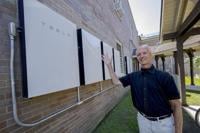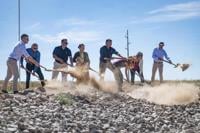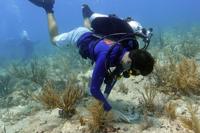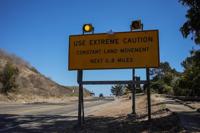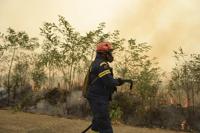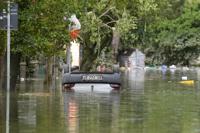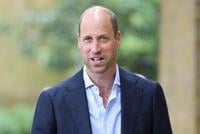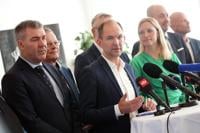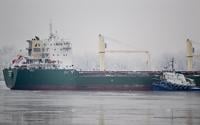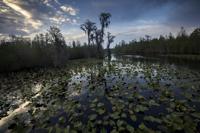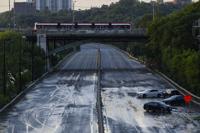NEW ORLEANS (AP) — As Hurricane Helene approaches the U.S. Gulf Coast, coming on the heels of another major storm two weeks ago, blackouts are all but certain in some areas. That carries extra risk for some people.
In New Orleans, Verna Lee and her husband Ronald Bailey, both 71, worry each time the lights go out, how long the batteries will last on the breathing machine Bailey relies on to keep his airways open at night. There is always that stressful decision to stay or to leave, with all the upheaval evacuation entails.
“Ron's always a little more willing to stay but it's like, he can't," Lee said. Two weeks ago when the lights went out during Hurricane Francine, "He was thinking he would just try to sleep sitting up,” she said. “When he lays down, he has to have that machine on to sleep because his breathing stops otherwise.”
Francine's wind and rain lashed the dark neighborhoods, flooding them as Lee and Bailey almost decided to slog through hours of traffic to evacuate and stay with relatives in Texas.
Then they remembered their neighborhood church still had its lights on. Inside First Grace United Methodist Church they found an air-conditioned refuge, a place to plug in their devices. They were able to charge the breathing machine and go back to sleep in their own home.
First Grace is part of the Community Lighthouse Project, an initiative born of hurricanes, to provide essentials like functioning electrical outlets and air conditioning to people facing blackouts, by building out solar panels on church roofs. The nonprofit Together New Orleans founded the project to turn the buildings into microgrids, meaning they generate and store their own electricity when the grid is down. There are now nine operating in New Orleans with a plan to expand to 86 across the city and 500 across the state.
The buildings keep operating through blackouts because they've installed batteries that charge up from the sun. Even if the batteries get drawn down, they recharge when the sun comes out.
Such self-sustaining microgrids have great potential for many places in the world that are slammed by increasingly intense hurricanes and typhoons.
One of the Community Lighthouse Project's founding members, Broderick Bagert, was motivated by his own searing experience.
His baby Isaiah was born with jaundice Aug. 21, 2012, just a few days before Hurricane Isaac hit. Doctors said the baby needed to be admitted to the hospital, but the storm was brewing in the Gulf. So they sent Bagert home with a light bed — a tiny container that exposes babies to blue light.
Then the power went out.
“I remember scurrying through the neighborhood, with a light bed under one arm and an eight-day-old child on the other,” Bagert said. He knew his sister had a generator and he made it to her house.
Isaiah made it through his jaundice.
But Bagert was left with frustration and outrage that communities like his on the frontlines of climate change have no safe spaces to go during a storm. Hurricane Ida came in 2021, 10 years after Isaac. Isaac had come seven years after Katrina. “It was like it just sunk in … they’re never going to do it,” he said about government officials building enough emergency shelters.
In the network of Community Lighthouses, First Grace has symbolic significance.
It was formed after wrecked two churches in 2005 – one historically white and one historically Black. They merged because members felt they could do more for the community together. These days, the congregation includes immaculately dressed elders and tattooed hipsters in shorts, all rising to sway to the gospel choir on Sundays.
There are reminders of what came before: Images of the old Black church's stained-glass windows are painted on the inner halls of First Grace, and across the street lies the stump of an old Confederate monument that the congregation advocated to remove.
Pastor Shawn Moses Anglim also helped found the network and remembers his heart sinking when he saw how the terracotta roof on First Grace’s sanctuary had been ripped off by Hurricane Ida. It made him passionate about providing a safe shelter during and after storms.
“We had no power for two weeks and it was hot,” said Anglim. “It’s like having an extra ten pounds of wet clothing and walking around in 90 degree weather. We’ve got to rethink this,” he remembers deciding.
Fast forward and two weeks ago, when Francine knocked out power, the church’s Tesla batteries kicked in, charged up by the solar panels on the roof. Text alerts notified the surrounding neighborhood and more than 100 people to show up.
Kids ran around with toy trucks and hula hoops. Parents caught a break and ate plates of jambalaya. Diego James, 14, plugged in his phone, played the church piano and helped distribute snacks. People could plug in dialysis machines. Others who didn't know each other chatted around the outlets.
“It gave that real sense of community that is so vital in life, especially in a crisis,” Anglim said. “People care about each other.”
The state's largest solar-plus-battery microgrid, New Wine Christian Fellowship, is in LaPlace, about a half hour drive west of New Orleans. New Wine is in St. John the Baptist Parish — the U.S. county ranked most vulnerable to climate change by the 2023 Climate Vulnerability Index. Pastor Neil Bernard has seen the impacts of climate change in his community, including homes destroyed by floods and health problems exacerbated by extreme heat. Bernard estimated during Francine, around 20 people came to stay overnight. He has room for 900 cots.
The Community Lighthouse Project has received $8.6 million from several cities in Louisiana, Sandia ������ϲʹ������� Laboratory, and a congressional allocation secured by Congressman Troy Carter. Additional funding is in the pipeline and will bring the total to $13 million.
Arthur Lee is president of Bethlehem Lutheran Church, another microgrid. He said people in New Orleans are having to deal with power outages all the time, and they're profoundly chaotic, even unsafe.
“When your power goes out, your world is shaken up, your loved ones are upset, you’re upset … everything is dark. But then they come to a safe beacon," Lee said.
___
O'Malley reported from Philadelphia, Brook from New Orleans.
___
The Associated Press’ climate and environmental coverage receives financial support from multiple private foundations. AP is solely responsible for all content. Find AP’s for working with philanthropies, a list of supporters and funded coverage areas at .


